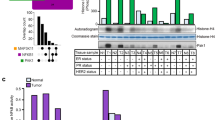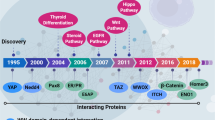Abstract
Amplification of the 8p11–12 region occurs in 15–20% of breast cancers, but the driving oncogene at this locus has yet to be definitively identified. We mapped the 8p11–12 amplicon in breast cancer cell lines and primary human breast cancers and identified the candidate oncogene human Sm-like protein (hLsm1, LSM1) based on increases in copy number and expression level relative to human mammary epithelial cells. To examine the oncogenic role of LSM1, we overexpressed this gene in MCF10A mammary epithelial cells and inhibited its production in the SUM44 breast cancer cell line, which has a natural amplification and overexpression of LSM1. Our data confirmed that LSM1 is an oncogene from the 8p11–12 amplicon by showing that hLsm1 overexpression induced growth factor-independent proliferation and soft agar colony formation in MCF10A cells, and hLsm1 inhibition in SUM44 cells dramatically reduced soft agar growth. Little is known about hLsm1 function other than its involvement in mRNA degradation; therefore, we used expression microarray analysis to investigate how hLsm1 affects cell transformation in MCF10A and SUM44 cells. We identified numerous genes altered following hLsm1 overexpression common to SUM44 breast cancer cells that play important roles in cell cycle regulation, cell proliferation and other cancer-promoting processes. Future work will continue to characterize these important changes to achieve a more complete understanding of the mechanism of hLsm1's effect on cancer progression.
This is a preview of subscription content, access via your institution
Access options
Subscribe to this journal
Receive 50 print issues and online access
$259.00 per year
only $5.18 per issue
Buy this article
- Purchase on Springer Link
- Instant access to full article PDF
Prices may be subject to local taxes which are calculated during checkout









Similar content being viewed by others
References
Bouveret E, Rigaut G, Shevchenko A, Wilm M, Seraphin B . (2000). A Sm-like protein complex that participates in mRNA degradation. EMBO J 19: 1661–1671.
Draghici S, Khatri P, Bhavsar P, Shah A, Krawetz SA, Tainsky MA . (2003a). Onto-Tools, the toolkit of the modern biologist: Onto-Express, Onto-Compare, Onto-Design and Onto-Translate. Nucleic Acids Res 31: 3775–3781.
Draghici S, Khatri P, Martins RP, Ostermeier GC, Krawetz SA . (2003b). Global functional profiling of gene expression. Genomics 81: 98–104.
Draghici S . (2003c). Data Analysis Tools for DNA Microarrays. Chapman and Hall/CRC Press: Boca Raton, FL, USA.
Ethier SP . (1996). Human breast cancer cell lines as models of growth regulation and disease progression. J Mammary Gland Biol Neoplasia 1: 111–121.
Ethier SP, Moorthy R . (1991). Multiple growth factor independence in rat mammary carcinoma cells. Breast Cancer Res Treat 18: 73–81.
Ethier SP, Summerfelt RM, Cundiff KC, Asch BB . (1991). The influence of growth factors on the proliferative potential of normal and primary breast cancer-derived human breast epithelial cells. Breast Cancer Res Treat 17: 221–230.
Forozan F, Veldman R, Ammerman CA, Parsa NZ, Kallioniemi A, Kallioniemi OP et al. (1999). Molecular cytogenetic analysis of 11 new breast cancer cell lines. Br J Cancer 81: 1328–1334.
Fraser MM, Watson PM, Fraig MM, Kelley JR, Nelson PS, Boylan AM et al. (2005). CaSm-mediated cellular transformation is associated with altered gene expression and messenger RNA stability. Cancer Res 65: 6228–6236.
Garcia MJ, Pole JC, Chin SF, Teschendorff A, Naderi A, Ozdag H et al. (2005). A 1 Mb minimal amplicon at 8p11–12 in breast cancer identifies new candidate oncogenes. Oncogene 24: 5235–5245.
Gelsi-Boyer V, Orsetti B, Cervera N, Finetti P, Sircoulomb F, Rouge C et al. (2005). Comprehensive profiling of 8p11–12 amplification in breast cancer. Mol Cancer Res 3: 655–667.
He W, Parker R . (2000). Functions of Lsm proteins in mRNA degradation and splicing. Curr Opin Cell Biol 12: 346–350.
Ingelfinger D, Arndt-Jovin DJ, Luhrmann R, Achsel T . (2002). The human LSm1-7 proteins colocalize with the mRNA-degrading enzymes Dcp1/2 and Xrnl in distinct cytoplasmic foci. RNA 8: 1489–1501.
Kelley JR, Fraser MM, Hubbard JM, Watson DK, Cole DJ . (2003). CaSm antisense gene therapy: a novel approach for the treatment of pancreatic cancer. Anticancer Res 23: 2007–2013.
Khatri P, Bhavsar P, Bawa G, Draghici S . (2004). Onto-Tools: an ensemble of web-accessible, ontology-based tools for the functional design and interpretation of high-throughput gene expression experiments. Nucleic Acids Res 32(Web Server issue): W449–W456.
Khatri P, Draghici S, Ostermeier GC, Krawetz SA . (2002). Profiling gene expression using onto-express. Genomics 79: 266–270.
Khatri P, Sellamuthu S, Malhotra P, Amin K, Done A, Draghici P . (2005). Recent additions and improvements to the Onto-Tools. Nucleic Acids Res 33(Web Server issue): W762–W765.
Li C, Wong WH . (2001). Model-based analysis of oligonucleotide arrays: expression index computation and outlier detection. Proc Natl Acad Sci USA 98: 31–36.
Livak KJ, Schmittgen TD . (2001). Analysis of relative gene expression data using real-time quantitative PCR and the 2(−Delta Delta C(T)) method. Methods 25: 402–408.
Paddison PJ, Caudy AA, Hannon GJ . (2002). Stable suppression of gene expression by RNAi in mammalian cells. Proc Natl Acad Sci USA 99: 1443–1448.
Paddison PJ, Hannon GJ . (2003). siRNAs and shRNAs: skeleton keys to the human genome. Curr Opin Mol Ther 5: 217–224.
Prentice LM, Shadeo A, Lestou VS, Miller MA, deLeeuw RJ, Makretsov N et al. (2005). NRG1 gene rearrangements in clinical breast cancer: identification of an adjacent novel amplicon associated with poor prognosis. Oncogene 24: 7281–7289.
Ray ME, Yang ZQ, Albertson D, Kleer CG, Washburn JG, Macoska JA et al. (2004). Genomic and expression analysis of the 8p11–12 amplicon in human breast cancer cell lines. Cancer Res 64: 40–47.
Schweinfest CW, Graber MW, Chapman JM, Papas TS, Baron PL, Watson DK . (1997). CaSm: an Sm-like protein that contributes to the transformed state in cancer cells. Cancer Res 57: 2961–2965.
Sheth U, Parker R . (2003). Decapping and decay of messenger RNA occur in cytoplasmic processing bodies. Science 300: 805–808.
Surmacz E . (2000). Function of the IGF-I receptor in breast cancer. J Mammary Gland Biol Neoplasia 5: 95–105.
Woods Ignatoski KM, Dziubinski ML, Ammerman C, Ethier SP . (2005). Cooperative interactions of HER-2 and HPV-16 oncoproteins in the malignant transformation of human mammary epithelial cells. Neoplasia 7: 788–798.
Yan Y, Rubinchik S, Wood AL, Gillanders WE, Dong JY, Watson DK et al. (2006). Bystander effect contributes to the antitumor efficacy of CaSm antisense gene therapy in a preclinical model of advanced pancreatic cancer. Mol Ther 13: 357–365.
Yang ZQ, Albertson D, Ethier SP . (2004). Genomic organization of the 8p11–p12 amplicon in three breast cancer cell lines. Cancer Genet Cytogenet 155: 57–62.
Zaric B, Chami M, Remigy H, Engel A, Ballmer-Hofer K, Winkler FK et al. (2005). Reconstitution of two recombinant LSm protein complexes reveals aspects of their architecture, assembly, and function. J Biol Chem 280: 16066–16075.
Acknowledgements
This work was supported by a grant from the National Cancer Institute (RO1 CA100724). Microarray experiments and analysis were performed by the Applied Genomics Technology Center at Wayne State University, which is funded by the Cancer Center Support Grant (P30 CA022453-25). Funding for Dr Sorin Draghici was provided by the following grants: NSF DBI-0234806, NIH R01 HG003491, NIH(NCRR) 1S10 RR01785701, NIH R21 CA10074001, 1R21 EB0099001 and 1R01NS04520701.
Author information
Authors and Affiliations
Corresponding author
Rights and permissions
About this article
Cite this article
Streicher, K., Yang, Z., Draghici, S. et al. Transforming function of the LSM1 oncogene in human breast cancers with the 8p11–12 amplicon. Oncogene 26, 2104–2114 (2007). https://doi.org/10.1038/sj.onc.1210002
Received:
Revised:
Accepted:
Published:
Issue Date:
DOI: https://doi.org/10.1038/sj.onc.1210002
Keywords
This article is cited by
-
Expression profile and prognostic values of LSM family in skin cutaneous melanoma
BMC Medical Genomics (2022)
-
Interpreting pathways to discover cancer driver genes with Moonlight
Nature Communications (2020)
-
Eukaryotic initiation factor 4E-binding protein as an oncogene in breast cancer
BMC Cancer (2019)
-
Development of mammary hyperplasia, dysplasia, and invasive ductal carcinoma in transgenic mice expressing the 8p11 amplicon oncogene NSD3
Breast Cancer Research and Treatment (2017)
-
The CaSm (LSm1) oncogene promotes transformation, chemoresistance and metastasis of pancreatic cancer cells
Oncogenesis (2016)



